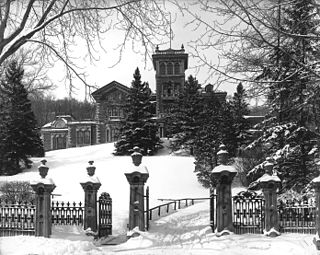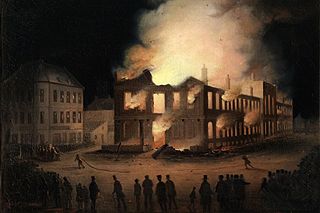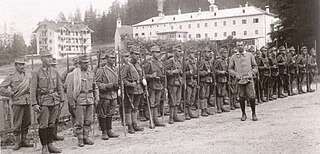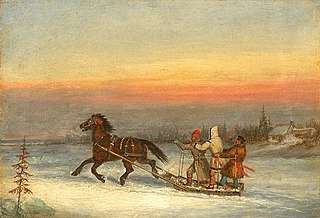
Snowshoes are specialized outdoor gear for walking over snow. Their large footprint spreads the user's weight out and allows them to travel largely on top of rather than through snow. Adjustable bindings attach them to appropriate winter footwear.

Mount Royal is a mountain in the city of Montreal, immediately west of Downtown Montreal, Quebec, Canada. The best-known hypothesis for the origin of the name Montreal is that the mountain is the namesake for the city.
A knit cap is a piece of knitted headwear designed to provide warmth in cold weather. It usually has a simple tapered shape, although more elaborate variants exist. Historically made of wool, it is now often made of synthetic fibers.

Montreal Amateur Athletic Association is Canada's oldest athletic association, located in Montreal, Quebec. It was renamed as the Club Sportif MAA or just MAA in 1999 after a brush with bankruptcy, but is still widely known as the MAAA. In the late 19th and early 20th centuries, the MAA was one of the most important sporting institutions in Canada, and North America, with affiliated teams winning ice hockey's Stanley Cup and Canadian football's Grey Cup.

Mer Bleue Bog is a 33.43 km2 (12.91 sq mi) protected area in Gloucester, Ontario, an eastern suburb of Ottawa in Eastern Ontario, Canada. Its main feature is a sphagnum bog that is situated in an ancient channel of the Ottawa River and is a remarkable boreal-like ecosystem normally not found this far south. Stunted black spruce, tamarack, bog rosemary, blueberry, and cottongrass are some of the unusual species that have adapted to the acidic waters of the bog.

Lieutenant-Colonel Sir Hugh Andrew Montagu Allan, was a Canadian businessman and philanthropist. He was the principal heir of his father, Sir Hugh Allan, and became deputy chairman of the family-owned Allan Steamship Line. He was president of several major Canadian financial institutions and of the Montreal General Hospital. He co-founded and was president of the Ritz-Carlton Hotel in Montreal. In 1940, he and his wife donated their Montreal home, Ravenscrag, to the McGill University Faculty of Medicine, and it became known as the Allan Memorial Institute. He is best remembered as a sportsman who donated the Allan Cup, a trophy that is still awarded today to the Canadian men's amateur ice hockey champions.

The Golden Square Mile, also known as the Square Mile, is the nostalgic name given to an urban neighbourhood developed principally between 1850 and 1930 at the foot of Mount Royal, in the west-central section of downtown Montreal in Quebec, Canada. The name 'Square Mile' has been used to refer to the area since the 1930s; prior to that, the neighbourhood was known as 'New Town' or 'Uptown'. The addition of 'Golden' was coined by Montreal journalist Charlie Lazarus, and the name has connections to contemporary real estate developments, as the historical delimitations of the Golden Square Mile overlap with Montreal's contemporary central business district.
The 65th Grey Cup, also known as The Ice Bowl, was played on November 27, 1977, at Montreal's Olympic Stadium. The hometown Montreal Alouettes defeated the Edmonton Eskimos by a score of 41–6.

The Battle of Saint-Denis was fought on November 23, 1837, between British colonial authorities under Lieutenant-Colonel Gore and Patriote rebels in Lower Canada as part of the Lower Canada Rebellion. The Patriotes were led by Wolfred Nelson. Gore was sent to quell the uprising in the Richelieu River valley in conjunction with a force led by Lieutenant-Colonel George Wetherall. Gore was the first to arrive at a Patriote-held site. Nelson had organized the defence with most of the well-armed rebels within a stone house that overlooked the road. Gore, accompanied by only one cannon, attempted to take the stone house three times, with the cannon providing ineffective fire. Another attempt to flank the house to the left failed when Gore's soldiers encountered the less well-armed militia. Running out of ammunition, the British retreated. This marked the only Patriote victory in 1837, as this battle was followed by two defeats at Saint-Charles and Saint-Eustache.
The Special Council of Lower Canada was an appointed body which administered Lower Canada until the Union Act of 1840 created the Province of Canada. Following the Lower Canada Rebellion, on March 27, 1838, the Constitutional Act of 1791 was suspended and both the Legislative Assembly and Legislative Council were dissolved.
Charles Oaks (Oakes) Ermatinger was an Ontario lawyer, judge and political figure. He represented Elgin East in the Legislative Assembly of Ontario from 1883 to 1886 as a Conservative member.

The burning of the Parliament Buildings in Montreal was an important event in pre-Confederation Canadian history and occurred on the night of April 25, 1849, in Montreal, the then-capital of the Province of Canada. It is considered a crucial moment in the development of the Canadian democratic tradition, largely as a consequence of how the matter was dealt with by then co-prime ministers of the united Province of Canada, Sir Louis-Hippolyte Lafontaine and Robert Baldwin.
Hugh Hamilton Lindsay (1802–1881) was a businessman with especial interest in China, perhaps the first Briton to visit Shanghai.

The Beaver Club was a gentleman's dining club founded in 1785 by the predominantly English-speaking men who had gained control of the fur trade of Montreal. According to the club's rules, the object of their meeting was "to bring together, at stated periods during the winter season, a set of men highly respectable in society, who had passed their best days in a savage country and had encountered the difficulties and dangers incident to a pursuit of the fur trade of Canada". Only fragmentary records remain of their meetings, but from these it is clear that the Beaver Club was "an animated expression of the esprit de corps of the North West Company". The men of the Beaver Club were the predecessors of Montreal's Square Milers.
Lt. Col. Alexander Allan Stevenson was a Canadian businessman, politician and military officer.

The Alpine companies were specialized mountain infantry troops that were part of the Austro-Hungarian land forces during the First World War.

A capote or capot is a long wrap-style wool coat with a hood.
The Montreal Winter Carnivals were week-long social and recreational festivals held during the 1880s in the city of Montreal, Quebec, Canada. Organized largely by the city's sporting clubs, the Winter Carnivals were centered on winter sports and other activities such as tobogganing and snowshoeing. More than this however, the carnivals helped to establish Montreal as a winter destination during the late nineteenth century.

Norway is a town in Oxford County, Maine, United States. Norway was included in the Lewiston-Auburn, Maine metropolitan New England city and town area. The population was 5,077 at the 2020 census. It is home to Lake Pennesseewassee, a recreation area.
The 1895 Birthday Honours were appointments by Queen Victoria to various orders and honours to reward and highlight good works by citizens of the British Empire. The appointments were made to celebrate the official birthday of The Queen, and were published in The Times on 25 May 1895 and in The London Gazette on 25 May 1895 and on 11 June 1895.















